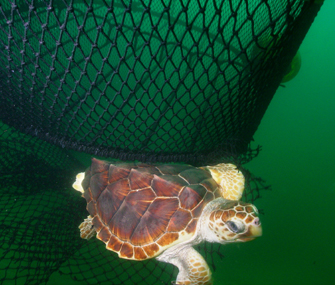World Turtle Day Spotlights Endangered and Threatened Reptiles
Published on May 15, 2013

May 23 is World Turtle Day, an annual event created to celebrate and increase awareness of turtle species around the world.
“Turtles are not as popular as cats and dogs, so interest, awareness and understanding is pretty slim,” says Susan Tellem, cofounder of American Tortoise Rescue. World Turtle Day was started 13 years ago by the ATR, who have rescued and rehomed over 3,000 turtles since Tellem and her husband founded the organization in 1990.
“This day is a good way to educate people about how to care for turtles, and to learn what danger they’re in and how to be more aware of what they need,” Tellem says.
Endangered and Threatened
According to ATR, turtles and tortoises are threatened by the exotic food trade, habitat destruction, global warming and the pet trade.
Tellem believes the illegal pet trade is significantly harming turtles of all kinds, as demand for turtles in pet stores remains high and continues to exceed demand for turtle adoption. In the illegal pet trade, turtles and tortoises are removed from their natural habitat and transported long distances to be sold, often in unsafe conditions.
“When turtles are transported they get stressed," says Tellem, which means that often a large percentage of turtles die while being transported from Russia and other countries.

As for marine turtles, National Oceanic and Atmospheric Administration’s national sea turtle coordinator Barbara Schroeder says all species are listed under the Endangered Species Act as threatened or endangered. There are seven sea turtle species worldwide, and six of those are located in U.S. waters.
“While there are some common themes of threats that are significant between terrestrial and sea turtles, in the marine environment, bycatch in fisheries is the major threat around the world,” Schroeder says.
Bycatch, the accidental capture of untargeted species by fishermen, occurs when sea turtles get caught in gear such as gillnets, trawls and longlines. Vessel strikes and habitat destruction around nesting beaches are also contributing to the loss of sea turtles.
Conservation and Success Stories
A wide range of programs across the country are dedicated to turtle conservation, prioritizing research and making sure federal activities don’t jeopardize species.
NOAA is involved in a number of sea turtle–specific conservation efforts such as reduction of bycatch, continued research of marine environments, and the development of recovery plans. Schroeder says the ultimate goal of all these efforts is to remove these species from the endangered species list.
While there is still a long way to go before that happens, conservation efforts have led to some success stories.
“Certainly there are species and regional populations doing much better than they were back in the 1960s and ’70s, when their listings first occurred under the act,” Schroeder says.
One example of this is the Kemp’s ridley sea turtle found on the Gulf Coast. The species was on the edge of extinction in the 1960s, according to Schroeder. It was only through a concentrated effort, which included the species being listed under the Endangered Species Act and decades of binational efforts with Mexico, that the population began to improve.
“They’re not recovered and not off the list, but they are moving in the right direction and their numbers are increasing steadily,” Schroeder says.

How You Can Help
There are a number of ways you can help endangered and threatened turtles.
“The biggest thing people can do to make a difference is not buy turtles from pet stores,” Tellem says. “There are so many available for adoption, there’s no need to buy one and contribute to the demand that feeds the cruel pet trade.” Petfinder offers turtles for adoption, and there are a wide variety of local turtle rescues in all parts of the country.
The ATR also recommends writing letters to legislators asking them to preserve habitats and reporting illegal sales of turtles to your local animal control shelter.
If you come across a turtle in your backyard, Tellem suggests releasing it into the wild if they are native to your area. If they’re not native, soak them in tepid water and place them in a box with a lid. Don’t panic if you find a water turtle and don’t have a pond or other facility to place it in. These turtles can be left out of water for about three to four days. Keep the box away from kids and dogs so the turtle isn’t disturbed and put it in a quiet place. Contact an organization like ATR who can help you find a new home for it and properly care for it in the meantime.
As for sea turtles, you can help them with acts as simple as not leaving trash on the beach and keeping an eye out for them if you boat in areas where they live. If you are near nesting beaches, follow lighting restrictions so you don’t disorient hatchlings, and refrain from spending time on the beach in areas where you can disturb them.
“What everybody can do is be aware of environmental legislation and requirements that may be proposed by federal or state governments to protect species,” Schroeder said. “Connect with environmental organizations working to preserve turtles. They always know what’s coming up and going on.”
Learn more about turtles and tortoises by visiting the American Tortoise Rescue and NOAA websites.
Read more Vetstreet coverage about endangered species and wildlife conservation.





